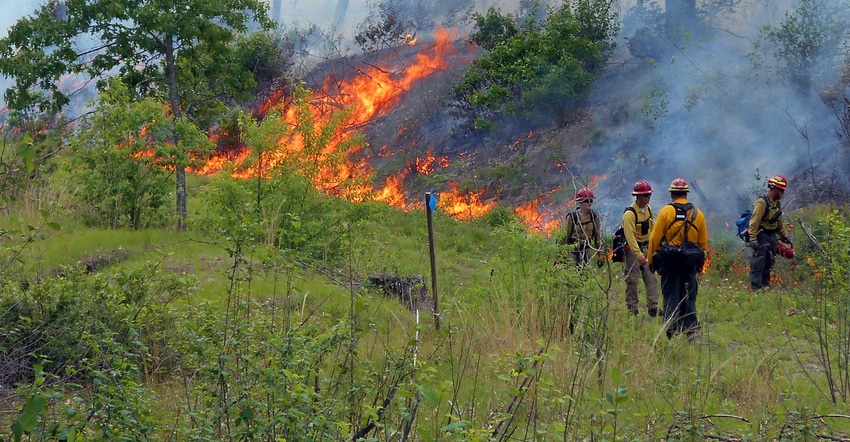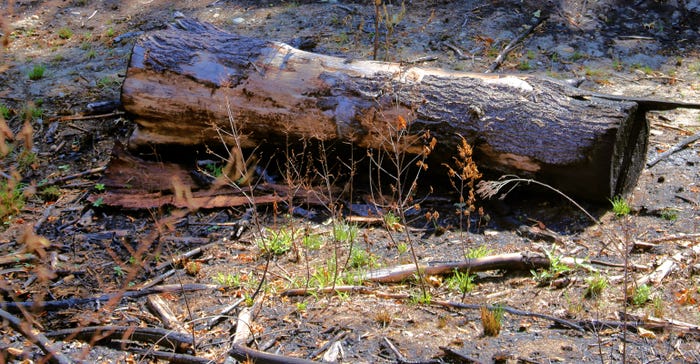April 21, 2017

By Diane Petit
USDA’s Natural Resources Conservation Service recently featured the regenerative efforts of reclaiming abandoned farmland near Ware, Mass., to productive forest use. It was done via a prescribed, controlled burn last June. Almost immediately, new life began springing up through the ashes.
When the East Quabbin Land Trust purchased the 90-acre Frohloff Farm in 2010, the first order of business was to get a forest stewardship plan. The farm hadn’t been managed as farmland in many years. Invasive species — glossy buckthorn, multiflora rose, bittersweet and honeysuckle — were taking over.
While the trust was interested in seeing agriculture continue, “We’re directly adjacent to the Ware River, and a priority water supply and habitat for wildlife, including the wood turtle,” explains Cynthia Henshaw, the trust’s executive director. The trust owns about 1,000 acres in central Massachusetts.
How this plan ‘fired up’
First, NRCS Soil Conservationist David Bacon helped get financial assistance through the Environmental Quality Incentives Program for the forest management plan. That plan called for commonly used conservation practices to restore native pitch pine, oak savannah bluff and lowbush blueberry heath ecosystems by clearing the land. It had been reforested with white pine, gray birch and invasive species.
EQIP provided financial and technical assistance to plan and implement conservation practices on this non-industrial forestland. Conservation program applications are eligible for higher practice payment rates for contracted conservation practices and activities.

EQUIPPING WITH EQIP: Henshaw and NRCS’s Bacon confer over EQIP-funded reforesting plan.

Cutting or mowing existing vegetation to allow more sunlight to reach the soil was part of the “early successional habitat development practice.” It allows desirable species to grow without competition of large, shade-producing canopy plants. Cutting or spraying the undesirable invasive brush species also helps desirable, native vegetation to thrive.
Opening up the forest canopy with fire was key. The trust contracted with Northeast Fire and Forest Management to conduct the burn. Help from Massachusetts Department of Conservation and Recreation Bureau of Forest Fire Control was also enlisted. Results were seen within weeks.
Fire used to be a natural part of the ecosystem, explains Dave Celino, DCR’s chief fire warden. “It burns off mulch layers. It's an immediate injection of potash into the soil, and it provides openings. Natural grasses respond very favorably.
“Why do we want to kill a certain amount of trees in the canopy? Well, there's a positive effect: They become wildlife condos,” says Celino. “In the fire business, we call them snag trees. But they become great wildlife habitat nesting trees.”
The burn was a very controlled, professional and impressive process. Henshaw says: “We had some pretty good flames and good heat.” Because it was an early-season fire and everything was very green, it burned much better than expected.
“Seeing new pitch pines come up, seeing the scrub oak continue, seeing the little bluestem grasses flourish; that's success,” she adds. “With those plant species will come all the invertebrates and all the animals that use those.

GREENING UP: Within a few weeks, a more diverse mix of native plants began springing from the ashes.

“One principal reason for burning is to promote the pitch pine and oak communities. Those species do really well under burns because their seeds can fall onto barren, mineral soil, where they can re-sprout without competition from white pine and gray birch.”
Petit is the public affairs officer for NRCS in Massachusetts.
Where prescribed burning fits
Prescribed burning is fire applied to a predetermined area within a prescribed set of conditions, dates and with appropriate safety precautions to achieve specific purposes. Those conditions must be approved by local and state agencies, and follow specific practices approved by NRCS. Cost-sharing may be available on some cases.
Prescribed burning can be applied to forest land, grassland, pastureland, wildlife land, hay ground and other land uses for the following purposes:
• controlling undesirable vegetation
• preparing sites for harvesting, planting or seeding
• controlling plant disease
• reducing wildfire hazards
• improving wildlife habitat
• improving plant production quantity and/or quality
• removing debris
• facilitating grazing and browsing animal distribution
• restoring and maintaining ecological sites
• managing native plant diversity/composition
Click on Prescribed burning for an NRCS fact sheet on the practice. For more specifics, click on Prescribed burn plan.
by John Vogel
You May Also Like




